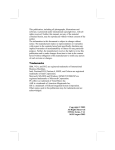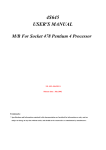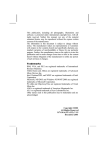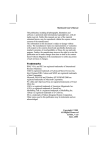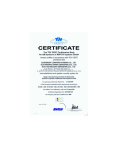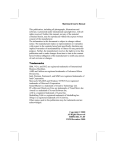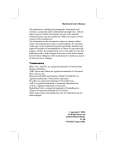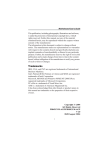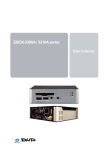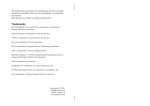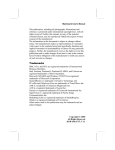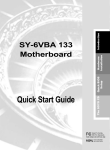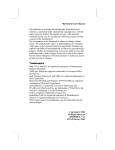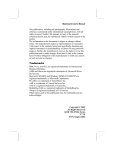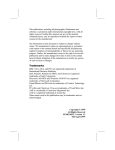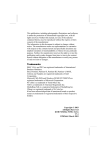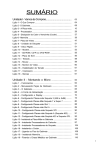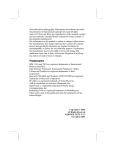Download User`s Manual - Motherboards.org
Transcript
Mainboard User’s Manual This publication, including all photographs, illustrations and software, is protected under international copyright laws, with all rights reserved. Neither this manual, nor any of the material contained herein, may be reproduced without the express written consent of the manufacturer. The information in this document is subject to change without notice. The manufacturer makes no representations or warranties with respect to the contents hereof and specifically disclaims any implied warranties of merchantability or fitness for any particular purpose. Further, the manufacturer reserves the right to revise this publication and to make changes from time to time in the content hereof without obligation of the manufacturer to notify any person of such revision or changes. Trademarks IBM, VGA, and PS/2 are registered trademarks of International Business Machines. AMD is registered trademark of Advanced Micro Devices Inc. Intel, Pentium/II/III, Celeron and MMX are registered trademarks of Intel Corporation. Microsoft, MS-DOS and Windows NT/95/98/ME/2000 are registered trademarks of Microsoft Corporation. PC-cillin and ChipAwayVirus are registered trademarks of Trend Micro Inc. AMI is a registered trademark of American Megatrends Inc. A3D is a registered trademark of Aureal Inc. MediaRing Talk is a registered trademark of MediaRing Inc. 3Deep is a registered trademark of E-Color Inc. SiS is a trademark of Silicon Integrated System Corporation. Other names used in this publication may be trademarks and are acknowledged. Copyright © 2001 All Rights Reserved M700 Series, V1.5 S635X/May 2001 Mainboard User’s Manual Notice for DDR SDRAM: The table below lists the model chips of DDR that we have tested. We will test more DDR modules in the future. Users may get this information from our World Wide Web at www.pcchips.com.tw. Model Chip K4H2808388-TCBO HY5DU28822T-H II Manufacture SAMSUNG HYUNDAI Mainboard User’s Manual Table of Contents Trademarks .............................................................................. I Chapter 1: Introduction....................................................................1 Key Features............................................................................2 Package Contents.....................................................................5 Static Electricity Precautions...................................................6 Pre-Installation Inspection.......................................................6 Chapter 2: Mainboard Installation...................................................7 Mainboard Components ..........................................................8 I/O Ports...................................................................................8 Install A CPU ..........................................................................9 Install Memory ......................................................................10 Setting Jumper Switches........................................................12 Install the Mainboard.............................................................13 Optional Extension Brackets .................................................14 Install Other Devices .............................................................15 Expansion Slots .....................................................................17 Chapter 3: BIOS Setup Utility.......................................................19 Introduction ...........................................................................19 Running the Setup Utility ......................................................20 Standard CMOS Setup Page..................................................21 Advanced Setup Page ............................................................22 Power Management Setup Page ............................................24 PCI / Plug and Play Setup Page.............................................25 Load Optimal Settings ...........................................................26 Load Best Performance Settings............................................26 Features Setup Page...............................................................26 CPU PnP Setup Page .............................................................28 Hardware Monitor Page.........................................................29 Change Password...................................................................29 Exit ........................................................................................30 Chapter 4: Software & Applications .............................................31 Introduction ...........................................................................31 Installing Support Software ...................................................31 Auto-installing under Windows 98........................................34 III Mainboard User’s Manual IV 1: Introduction Chapter 1 Introduction This mainboard has a Socket-370 processor socket for an Intel FCPGA Celeron or FCPGA Pentium III processor. You can install any one of these processors on the mainboard. The mainboard supports front-side bus speeds of 66MHz, 100MHz or 133MHz. This mainboard uses the SiS 635/T chipset which supports a 4X AGP slot for highly graphics display, DDR interface and Ultra DMA 33/66/100 function, provides outstanding high system performance under all types of system operations. The mainboard has a built-in AC97 Codec, provides an AMR (Audio Modem Riser) slot to support Audio and Modem application. In addition, the mainboard has an extended set of ATX I/O Ports including PS/2 keyboard and mouse ports, two USB ports, a parallel port, and two serial ports. Two extra USB ports can be added using the Extended USB Module that connects to the mainboard. This mainboard has all the features you need to develop a powerful multimedia workstation. The board is ATX size and has power connectors for an ATX power supply. 1 Mainboard User’s Manual Key Features The key features of this mainboard include: Socket-370 Processor Support ♦ Supports FCPGA Celeron and FCPGA Pentium III CPUs ♦ Supports 66MHz, 100MHz or 133MHz Front-Side Bus ♦ Asynchronous Host/DRAM Clock Scheme at the combinations of 133/133, 133/200, 133/266, 100/133, 100/200, 100/266, 66/66, 66/100 and 66/200. Notice: This mainboard does not support PPGA Celeron CPUs. Memory Support ♦ Two 168-pin DIMM slots for SDRAM memory modules ♦ Two 184-pin DIMM slots for DDR memory modules ♦ Support SDRAM up to 133 MHz /DDR up to 266 MHz memory bus ♦ Maximum installed memory is 1GB Notice: You can NOT use SDRAM and DDR simultaneously. Expansion Slots ♦ One AMR slot for a special audio/modem riser card ♦ One AGP4X slot for AGP 2.0-compliant interface ♦ Five 32-bit PCI slots for PCI 2.2-compliant bus interface Onboard IDE channels ♦ Primary and Secondary PCI IDE channels ♦ Support for PIO (programmable input/output) modes ♦ Support for Multiword DMA modes ♦ Support for Bus Mastering and Ultra DMA 33/66/100 modes 2 1: Introduction Power Supply and Power Management ♦ ATX power supply connector ♦ Meets ACPI 1.0b and APM 1.2 requirements, keyboard power on/off ♦ Supports RTC Alarm, Wake On Modem, AC97 Wake-Up and USB Wake-Up AC97 Codec ♦ Compliant AC97 2.1 specification ♦ Supports 18-bit ADC (Analog Digital Converter) and DAC (Digital Analog Converter) as well as 18-bit stereo fullduplex codec Onboard I/O Ports ♦ Built-in Multi-threaded IO Link Delivering 1.2GB/s ♦ Provides PC99 Color Connectors for easy peripheral device connections ♦ Floppy disk drive connector with 1Mb/s transfer rate ♦ Two serial ports with 16550-compatible fast UART ♦ One parallel port with ECP and EPP support ♦ Two USB ports and optional two USB ports module ♦ Two PS/2 ports for keyboard and mouse ♦ One infrared port connector for optional module Hardware Monitoring ♦ Built-in hardware monitoring for CPU & System temperatures, fan speeds and mainboard voltages Onboard Flash ROM ♦ Supports Plug and Play configuration of peripheral devices and expansion cards ♦ Built-in virus protection using Trend’s ChipAwayVirus provides boot process virus protection. 3 Mainboard User’s Manual Bundled Software ♦ PC-Cillin2000 provides automatic virus protection under Windows 95/98/NT/2000 ♦ MediaRing Talk provides PC to PC or PC to Phone internet phone communication ♦ 3Deep delivers the precise imagery and displays accurate color in your monitor ♦ WinDVD2000 is a DVD playback application (optional) Dimensions ♦ ATX form factor (30.5cm x 22cm) 4 1: Introduction Package Contents Attention: This mainboard series includes two different models. They are M700MR (Modem Ready) and M700 (without Modem). Please contact your local supplier for your purchase model. Each model will support different specification, list as below: Model Specification M700MR An AMR Fax/Modem card M700 --Your mainboard package ships with the following items: The mainboard This User’s Guide 1 UDMA/66 IDE cable 1 Floppy disk drive cable Support software on CD-ROM disk Optional Accessories You can purchase the following optional accessories for this mainboard. Extended USB module 5 Mainboard User’s Manual Static Electricity Precautions Components on this mainboard can be damaged by static electricity. Take the following precautions when unpacking the mainboard and installing it in a system. 1. Keep the mainboard and other components in their original static-proof packaging until you are ready to install them. 2. During installation, wear a grounded wrist strap if possible. If you don’t have a wrist strap, discharge static electricity by touching the bare metal of the system chassis. 3. Handle the mainboard carefully by the edges. Avoid touching the components unless it is absolutely necessary. During installation put the mainboard on top of the static-protection packaging it came in with the component side facing up. Pre-Installation Inspection 1. Inspect the mainboard for damage to the components and connectors on the board. 2. If you suspect that the mainboard has been damaged, do not connect power to the system. Contact your mainboard vendor and report the damage. 6 2: Mainboard Installation Chapter 2 Mainboard Installation To install this mainboard in a system, follow the procedures in this chapter: Identify the mainboard components Install a CPU Install one or more system memory modules Verify that any jumpers or switches are set correctly Install the mainboard in a system chassis (case) Connect any extension brackets or cables to the mainboard connector headers Install any other devices and make the appropriate connections to the mainboard connector headers. Note: 1. Before installing this mainboard, make sure jumper JP6 set to Normal setting. See this chapter for information on locating JP6 and the setting options. 2. Never connect power to the system during installation. Doing so may damage the mainboard. 7 Mainboard User’s Manual Mainboard Components Use the diagram below to identify the major components on the mainboard. Note: Any jumper on your mainboard that do not appear in the illustration above is for testing only. I/O Ports The illustration below shows a side view of the built-in I/O ports on the mainboard. PS/2 Mouse USB Ports PS/2 Keyboard Game/MIDI Port Parallel Port Serial COM1/3 Line Out Serial COM2/4 8 Microphone Line In 2: Mainboard Installation Install A CPU This mainboard has a Socket-370 which supports FCPGA Celeron and FCPGA Pentium III processors. To ensure reliability, ensure that your processor has a heatsink/cooling fan assembly. Do not try to install a Socket-462/Socket-7 processor in the Socket370. A Socket-462/Socket-7 processor such as the AMD K7/ K6/K5, or the Pentium-MMX does not fit in the Socket 370. The following list notes the processors that are currently supported by this mainboard. FCPGA Pentium III: 500~1130MHz, FSB: 100MHz, 133MHz FCPGA Celeron: 533~800MHz, FSB: 66 MHz Notice: This mainboard does not support PPGA Celeron CPUs. Installing a Socket-370 Processor A processor installs into the ZIF (Zero Insertion Force) Socket-370 on the mainboard. 1. Locate the Socket-370 and FAN2. Pull the locking lever out slightly from the socket and raise it to the upright position. Pin-1 Corner FAN2 Socket-370 2. On the processor, identify the Pin-1 corner by its beveled edge. 3. On the Socket-370, identify the Pin-1 corner. The Pin-1 corner is at the top of the locking lever when it locked. 9 Mainboard User’s Manual 4. Match the Pin-1 corners and insert the processor into the socket. No force is required and the processor should drop into place freely. 5. Swing the locking lever down and hook it under the catch on the side of the socket. This secures the CPU in the socket. 6. All processors should be installed with a combination heatsink/cooling fan, connect the cable from the fan to the CPU fan power connector FAN2. Install Memory The mainboard has two 168-pin/184-pin DIMM sockets for SDRAM/DDR (Double Data Rate) SDRAM system memory modules. You must install at least one memory module in order to use the mainboard, and you can only use one of the both SDRAM and DDR SDRAM at the same time. DDR SDRAM provides 800 MBps or 1 GBps data transfer depending on whether the bus is 100 MHz or 133 MHz. It doubles the rate to 1.6 GBps and 2.1 GBps by transferring data on both the rising and falling edges of the clock. DDR SDRAM uses additional power and ground lines and requires 184-pin 2.5V unbuffered DIMM module reather than the 168-pin 3.3V unbuffered DIMMs used by SDRAM. DDR1 DDR2 DIMM1 DIMM2 For this mainboard, the maximum memory size is 1GB. The edge connectors on the memory modules have cut outs, which coincide with spacers in the DIMM sockets so that memory module can only be installed in the correct orientation. 10 2: Mainboard Installation To install a module, push the retaining latches at either end of the socket outwards. Position the memory module correctly and insert it into the DIMM socket. Press the module down into the socket so that the retaining latches rotate up and secure the module in place by fitting into notches on the edge of the module. The table below lists the model chips of DDR that we have tested. Model Chip K4H2808388-TCBO HY5DU28822T-H Manufacture SAMSUNG HYUNDAI 11 Mainboard User’s Manual Setting Jumper Switches Jumpers are sets of pins which can be connected together with jumper caps. The jumper caps change the way the mainboard operates by changing the electronic circuits on the mainboard. If a jumper cap connects two pins, we say the pins are SHORT. If a jumper cap is removed from two pins, the pins are OPEN. JP1 1 1 JP6 Jumper JP1: Keyboard Power On Selector If you enable the keyboard power on feature, you can use hot keys on your keyboard as a power on/off switch for the system. Note: The system must provide 1A on the +5VSB (+5V Standby) signal before using the Keyboard Power On function. Function Disable Keyboard Power On Enable Keyboard Power On Jumper Setting Short Pins 1-2 Short Pins 2-3 Jumper JP6: Clear CMOS Memory Use this jumper to clear the contents of the CMOS memory. You may need to clear the CMOS memory if the settings in the Setup Utility are incorrect and prevent your mainboard from operating. To clear the CMOS memory, disconnect all the power cables from the mainboard and then move the jumper cap into the CLEAR setting for a few seconds. Function Clear CMOS Memory Normal Operation 12 Jumper Setting Short Pins 1-2 Short Pins 2-3 2: Mainboard Installation Install the Mainboard Install the mainboard in a system chassis (case). The board is an ATX size mainboard with a twin-tier of I/O ports. You can install this mainboard in an ATX case. Ensure that your case has an I/O cover plate that matches the ports on this mainboard. Install the mainboard in a case. Follow the instructions provided by the case manufacturer using the hardware and internal mounting points on the chassis. FAN1 ATX1 SW1 AUDIO1 1 SPK1 Connect the power connector from the power supply to the ATX1 connector on the mainboard. If there is a cooling fan installed in the system chassis, connect the cable from the cooling fan to the FAN1 fan power connector on the mainboard. Connect the cable from the PC speaker to the SPK1 header on the mainboard. Connect the case switches and indicator LEDs to the SW1 header. If there are a headphone jack or/and a microphone jack on the front panel, connect the cables to the AUDIO1 header on the mainboard. See the illustrations below for the guide to the SW1 and AUDIO1 headers pin assignments. AUDIO1 1 2 HDD LED P1-3 Power/ACPI LED P2-4 Power Button P6-8 Reset Switch P5-7 MIC 1 MIC-P 3 FPOUT-R 5 NC 7 FPOUT-L 9 2 GND 4 VCC 6 RET-R 8 Key 10 RET-L SW1 13 Mainboard User’s Manual Optional Extension Brackets For this mainboard, you can also obtain a USB module extension bracket. Install them by following the steps below. Note: All the ribbon cables used on the extension brackets have a red stripe on the Pin-1 side of the cable. Extended USB Module This module bracket has two USB ports for more USB devices (USB port 3-4). USB1 1 1. Locate the USB1 header on the mainboard. 2. Plug the bracket cable onto the USB1 header. 3. In the system chassis, remove a slot cover from one of the expansion slots and install the extension bracket in the opening. Use the screw that held the slot cover in place to secure the extension bracket to the chassis. 14 2: Mainboard Installation Install Other Devices Install and connect any other devices in the system following the steps below. 1 1 1 FDC IDE1 IDE2 Floppy Disk Drive The mainboard ships with a floppy disk drive cable that can support one or two drives. Drives can be 3.5” or 5.25” wide, with capacities of 360K, 720K, 1.2MB, 1.44MB, or 2.88MB. Install your drives and connect power from the system power supply. Use the cable provided to connect the drives to the floppy disk drive connector FDC. IDE Devices IDE devices include hard disk drives, high-density diskette drives, and CD-ROM or DVD-ROM drives, among others. The mainboard ships with an IDE cable that can support one or two IDE devices. If you connect two devices to a single cable, you must configure one of the drives as Master and one of the drives as Slave. The documentation of the IDE device will tell you how to configure the device as a Master or Slave device. The Master device connects to the end of the cable. Install the device(s) and connect power from the system power supply. Use the cable provided to connect the device(s) to the Primary IDE channel connector IDE1 on the mainboard. If you want to install more IDE devices, you can purchase a second IDE cable and connect one or two devices to the Secondary IDE channel connector IDE2 on the mainboard. If you have two devices on the cable, one must be Master and one must be Slave. 15 Mainboard User’s Manual Internal Sound Connections If you have installed a CD-ROM drive or DVD-ROM drive, you can connect the drive audio cable to the onboard sound system. On the mainboard, locate the two 4-pin connectors CD1 and CD2. There are two kinds of connector because different brands of CDROM drive have different kinds of audio cable connectors. Connect the cable to the appropriate connector. CD1 CD2 1 IR1 FIR 1 +5V 3 IRTX 5 2 Key 4 GND 6 IRRX Infrared Port You can connect an infrared port to the mainboard. You can purchase this option from third-party vendors. 1. Locate the infrared port IR1 header on the mainboard. 2. If you are adding an infrared port, connect the ribbon cable from the port to the IR1 header and then secure the port to an appropriate place in your system chassis. 16 2: Mainboard Installation Expansion Slots This mainboard has five 32-bit PCI slots, one AGP slot and one AMR slot. PCI5 PCI3 PCI1 AMR1 AGP1 PCI4 PCI2 Follow the steps below to install a PCI/AGP/AMR expansion card. 1. Locate the AMR, AGP or PCI slots on the mainboard. 2. Remove the slot cover for this slot from the system chassis. 3. Insert the expansion card edge connector into the slot and press it firmly down into it so that it is fully inserted. 4. Secure the expansion card bracket to the system chassis using the screw that held the slot cover in place. AMR Slot The AMR (Audio Modem Riser) slot is an industry standard slot that allows for the installation of a special audio/modem riser card. Different territories have different regulations regarding the specifications of a modem card. You can purchase an AMR card that is approved in your area and install it directly into the AMR slot. 17 Mainboard User’s Manual 18 3: BIOS Setup Utility Chapter 3 BIOS Setup Utility Introduction The BIOS Setup Utility records settings and information about your computer such as the date and time, the kind of hardware installed, and various configuration settings. Your computer uses this information to initialize all the components when booting up and functions as the basis for coordination between system components. If the Setup Utility configuration is incorrect, it may cause the system to malfunction. It can even stop your computer from booting properly. If this happens, you can use the clear CMOS jumper to clear the CMOS memory used to store the configuration information. You can run the setup utility and manually make changes to the configuration. You might need to do this to configure some of the hardware that you install on or connect to the mainboard, such as the CPU, system memory, disk drives, etc. 19 Mainboard User’s Manual Running the Setup Utility Each time your computer starts, before the operating system loads, a message appears on the screen that prompts you to “Hit <DEL> if you want to run SETUP”. When you see this message, press the Delete key and the Main menu page of the Setup Utility appears on your monitor. Standard CMOS Setup Features Setup Advanced Setup CPU PnP Setup Power Management Setup Hardware Monitor PCI / Plug and Play Setup Change Password Load Optimal Settings Exit Load Best Performance Settings ESC: Quit ↑↓←→ : Select Item (Shift)F2 : Change Color F6: Optimal values F7: Best performance values F5 : Old Values F10: Save&Exit You can use the cursor arrow keys to highlight any of the options on the main menu page. Press Enter to select the highlighted option. To leave the setup utility, press the Escape key. To cycle through the Setup Utility’s optional color schemes hold down the Shift key and press F2. Some of the options on the main menu page lead to tables of items with installed values. In these pages, use the cursor arrow keys to highlight the items, and then use the PgUp and PgDn keys to cycle through the alternate values for each of the items. Other options on the main menu page lead to dialog boxes which require you to answer Yes or No by hitting the Y or N keys. If you have already made changes to the setup utility, press F10 to save those changes and exit the utility. Press F5 to reset the changes to the original values. Press F6 to install the setup utility with a set of default values. Press F7 to install the setup utility with a set of high-performance values. 20 3: BIOS Setup Utility Standard CMOS Setup Page Use this page to set basic information such as the date, the time, the IDE devices, and the diskette drives. If you press the F3 key, the system will automatically detect and configure the hard disks on the IDE channels. Date (mm/dd/yy) : Tue Apr 10, 2001 Time (hh/mm/ss) : 14:26:53 Pri Master : Pri Slave : Sec Master : Sec Slave : Type Auto Auto Auto Auto LBA Blk PIO 32Bit Size Cyln Head WPcom Sec Mode Mode Mode Mode On On On On Floppy Drive A : 1.44MB 3 1/2” Floppy Drive B : Not Installed Month : Jan – Dec Day : 01 – 31 Year : 1901 – 2099 Date & Time Pri Master Pri Slave Sec Master Sec Slave Floppy Drive A Floppy Drive B ESC : Exit ↑↓ : Select Item PU/PD/+/- : Modify (Shift)F2 : Color F3 : Detect All HDD Use these items to set the system date and time Use these items to configure devices connected to the Primary and Secondary IDE channels. To configure an IDE hard disk drive, choose Auto. If the Auto setting fails to find a hard disk drive, set it to User, and then fill in the hard disk characteristics (Size, Cyls, etc.) manually. If you have a CD-ROM drive, select the setting CDROM. If you have an ATAPI device with removable media (e.g. a ZIP drive or an LS-120) select Floptical. Use these items to set the size and capacity of the floppy diskette drive(s) installed in the system. 21 Mainboard User’s Manual Advanced Setup Page Use this page to set more advanced information about your system. Take some care with this page. Making changes can affect the operation of your computer. Trend ChipAway Virus Quick Boot 1st Boot Device 2nd Boot Device 3rd Boot Device Try Other Boot Devices S.M.A.R.T. for Hard Disks BootUp Num-Lock Floppy Drive Swap Floppy Drive Seek Password Check Boot To OS/2 > 64MB L1 Cache L2 Cache System BIOS Cacheable Timing Setting Mode DRAM CAS# Latency IDE USE BUS Disabled Enabled IDE-0 Floppy CDROM Yes Disabled On Disabled Disabled Setup No Enabled Enabled Enabled Normal 3T Auto ESC F1 F5 F6 F7 : : : : : Quit ↑↓←→ : Select Item Help PU/PD/+/- : Modify Old Values (Shift)F2 : Color Load Optimal values Load Best performance values Trend ChipAway Virus This mainboard has built-in virus protection in the BIOS. Use this item to enable or disable the built-in virus protection. If the OS (like Windows 98SE Japanese Version) needs to run EMM386.EXE and this item is enable, please add the NOEMS parameter (e.g.: EMM386 NOEMS) on it. Quick Boot If you enable this item, the system starts up more quickly be elimination some of the power on test routines. 1st Boot Device 2nd Boot Device 3rd Boot Device Try Other Boot Device Use these items to determine the device order the computer uses to look for an operating system to load at start-up time. S.M.A.R.T. for Hard Disks Enable this item if any IDE hard disks support the S.M.A.R.T. (Self-Monitoring, Analysis and Reporting Technology) feature. BootUp NumLock This items determines if the Num Lock key is active or inactive at system start-up time. 22 If you enable this item, the system will also search for other boot devices if it fails to find an operating system from the first two locations. 3: BIOS Setup Utility Floppy Drive Swap If you have two diskette drives installed and you enable this item, drive A becomes drive B and drive B becomes drive A. Floppy Drive Seek If you enable this item, your system will check all floppy disk drives at start up. Disable this item unless you are using an old 360KB drive. Password Check If you have entered a password for the system, use this item to determine if the password is required to enter the Setup Utility (Setup) or required both at start-up and to enter the Setup Utility (Always). Boot to OS/2 > 64MB Enable this item if you are booting the OS/2 operating system and you have more than 64MB of system memory installed. L1/L2 Cache Leave these items enabled since all the processors that can be installed on this board have internal cache memory. System BIOS Cacheable If you enable this item, a segment of the system BIOS will be cached to main memory for faster execution. Timing Setting Mode Use this item to determine the timing setting mode of the memory. We recommend that you leave this item at the default value. DRAM CAS# Latency This item determines the operation of the SDRAM memory CAS (column address strobe). We recommend that you leave this item at the default value. The 2T setting requires faster memory that specifically supports this mode. IDE USE BUS This item determines the IDE channels to use PCI bus or Fast Embedded bus. We recommend that you leave this item at the default value. 23 Mainboard User’s Manual Power Management Setup Page This page sets some of the parameters for system power management operation. ACPI Aware O/S Power Management Suspend Time Out Hard Disk Time Out Ring On Power On RTC Alarm Power On RTC Alarm Date RTC Alarm Hour RTC Alarm Minute RTC Alarm Second KeyBoard PowerOn Function Yes Enabled Disabled Disabled Disabled Disabled Every Day 12 30 00 Disabled ESC F1 F5 F6 F7 : : : : : Quit ↑↓←→ : Select Item Help PU/PD/+/- : Modify Old Values (Shift)F2 : Color Load Optimal values Load Best performance values ACPI Aware O/S Enable this item if you are using an O/S that supports ACPI function such as Windows 98/ME /2000. Power Management Suspend Time Out Use this item to select a power management scheme. Both APM and ACPI are supported. Hard Disk Time Out This sets the timeout to power down the hard disk drive, if the time selected passes without any hard disk activity. Ring On Power On The system can be turned off with a software command. If you enable this item, the system can automatically resume if there is an incoming call on the Fax/Modem. You must use an ATX power supply in order to use this feature. RTC Alarm Power On / Date / Hour / Minute / Second The system can be turned off with a software command. If you enable this item, the system can automatically resume at a fixed time based on the system’s RTC (realtime clock). Use the items below this one to set the date and time of the wake-up alarm. You must use an ATX power supply in order to use this feature. 24 This sets the timeout for Suspend mode in minutes. If the time selected passes without any system activity, the computer will enter powersaving Suspend mode. 3: BIOS Setup Utility KeyBoard Power On Function If you enable this item, you can turn the system on and off by pressing hot keys on the keyboard. You must enable the Keyboard Power On jumper and use an ATX power supply in order to use this feature. PCI / Plug and Play Setup Page This page sets some of the parameters for devices installed on the PCI bus and devices that use the system plug and play capability. Plug and Play Aware O/S Primary Graphics Adapter Allocate IRQ to PCI VGA Yes PCI Yes ESC F1 F5 F6 F7 : : : : : Quit ↑↓←→ : Select Item Help PU/PD/+/- : Modify Old Values (Shift)F2 : Color Load Optimal values Load Best performance values Plug and Play Aware O/S Enable this item if you are using an O/S that supports Plug and Play such as Windows 95/98/ME. Primary Graphics Adapter This item indicates if the primary graphics adapter uses the PCI or the AGP bus. The default PCI setting still lets the onboard display work and allows the use of a second display card installed in a PCI slot. Allocate IRQ to PCI VGA If this item is enabled, an IRQ will be assigned to the PCI VGA graphics system. You set this value to No to free up an IRQ. 25 Mainboard User’s Manual Load Optimal Settings If you select this item and press Enter a dialog box appears. If you press Y, and then Enter, the Setup Utility loads a set of fail-safe default values. These default values are not very demanding and they should allow your system to function with most kinds of hardware and memory chips. Load Best Performance Settings If you select this item and press Enter a dialog box appears. If you press Y, and then Enter, the Setup Utility loads a set of bestperformance default values. These default values are quite demanding and your system might not function properly if you are using slower memory chips or other low-performance components. Features Setup Page This page sets some of the parameters for peripheral devices connected to the system. OnBoard FDC OnBoard Serial PortA OnBoard Serial PortB Serial Port2 Mode OnBoard Parallel Port Parallel Port Mode Parallel Port IRQ Parallel Port DMA OnBoard Game Port OnBoard MIDI Port MIDI Port IRQ OnBoard PCI IDE OnBoard AC’97 Sound OnBoard AC’97 Modem USB Function Support USB Function for DOS Enabled 3F8h/COM1 2F8h/COM2 Normal 378h Normal 7 N/A 201h 300h 10 Both Enabled Enabled ESC : Quit ↑↓←→ : Select Item Enabled F1 : Help PU/PD/+/- : Modify Disabled F5 : Old Values (Shift)F2 : Color F6 : Load Optimal values F7 : Load Best performance values OnBoard FDC Use this item to enable or disable the onboard floppy disk drive interface. OnBoard Serial PortA/B Use these items to enable or disable the onboard COM1/2 serial port, and to assign a port address. 26 3: BIOS Setup Utility Serial Port2 Mode Use this item to allocate the resources of the second serial port. Under Normal, the resources are allocated to the onboard serial port. Under ASKIR or IrDA, the resources are allocated to the onboard IR port. Onboard Parallel Port Use this item to enable or disable the onboard LPT1 parallel port, and to assign a port address. The Auto setting will detect and available address. Parallel Port Mode Use this item to set the parallel port mode. You can select SPP (Standard Parallel Port), ECP (Extended Capabilities Port), EPP (Enhanced Parallel Port), or ECP + EPP. Parallel Port IRQ Use this item to assign either IRQ 5 or 7 to the parallel port. Parallel Port DMA Use this item to assign a DMA channel to the parallel port. The options are 0, 1 and 3. OnBoard Game Port OnBoard MIDI Port Use this item to enable or disable the onboard Game port. MIDI Port IRQ Onboard PCI IDE Use this item to assign an IRQ to the MIDI port. Onboard AC’97 Sound Onboard AC’97 Modem USB Function Support USB Function for DOS This item enables or disables the onboard AC’97 audio chip. Use this item to enable or disable the onboard MIDI port, and to assign a port address. Use this item to enable or disable either or both of the onboard Primary and Secondary IDE channels. This item enables or disables the onboard AC’97 modem chip. Enable this item if you plan to use the USB ports on this mainboard. Enable this item if you plan to use the USB ports on this mainboard in a DOS environment. 27 Mainboard User’s Manual CPU PnP Setup Page This page lets you manually configure the mainboard for the CPU. The system will automatically detect the kind of CPU that you have installed and make the appropriate adjustments to the items on this page. CPU/DRAM Base Frequency CPU Multiple Factory HOST Frequency DRAM Frequency 66/66 MHz X2.5 66MHz 66MHz ESC F1 F5 F6 F7 : : : : : Quit ↑↓←→ : Select Item Help PU/PD/+/- : Modify Old Values (Shift)F2 : Color Load Optimal values Load Best performance values CPU/DRAM Base Frequency Use this item to set the external clock frequency for the CPU and the memory bus frequency. The options include combinations of 66, 100 and 133MHz. Set the CPU clock based on the requirements of the CPU installed on the board. Select the memory frequency based on the speed of the memory installed on the board. CPU Multiple Factory Use this item to set a multiplier for the CPU external frequency. The multiplier times the external CPU frequency sets the internal clock speed of the CPU, e.g. 100 MHz (external clock or “FSB”) x 4.5 (muliplier) = 450 MHz (internal clock speed of the installed CPU). HOST/DRAM Frequency These items display the external clock frequency for the CPU/the memory bus frequency, based on the CPU/DRAM Base Frequency item. 28 3: BIOS Setup Utility Hardware Monitor Page This page sets some of the parameters for the hardware monitoring function of this mainboard. AMIBIOS SETUP – HARDWARE MONITOR (C) 2000 American Megatrends, Inc. All Rights Reserved --- System Hardware --Vcore 2.000 V Vcc2.5V 2.500 V Vcc3.3V 3.300 V Vcc5V 5.000 V +12V 12.000 V SB3V 3.300 V -12V -12.000 V SB5V 5.000 V VBAT 3.300 V System Fan Speed CPU Fan Speed System Temperature CPU Temperature 30°C/86°F Voltage Measurements & FAN Speeds System / CPU Temperature ESC F1 F5 F6 F7 : : : : : Quit ↑↓←→ : Select Item Help PU/PD/+/- : Modify Old Values (Shift)F2 : Color Load Optimal values Load Best performance values These items indicate cooling fan speeds in RPM and the various system voltage measurements. These items display CPU and system temperature measurement. Change Password If you highlight this item and press Enter, a dialog box appears which lets you enter a Supervisor password. You can enter no more than six letters or numbers. Press Enter after you have typed in the password. A second dialog box asks you to retype the password for confirmation. Press Enter after you have retyped it correctly. The password is then required to access the Setup Utility or for that and at start-up, depending on the setting of the Password Check item in Advanced Setup. 29 Mainboard User’s Manual Change or Remove the Password Highlight this item, press Enter and type in the current password. At the next dialog box, type in the new password, or just press Enter to disable password protection. Exit Highlight this item and press Enter to save the changes that you have made in the Setup Utility configuration and exit the program. When the Save and Exit dialog box appears, press Y to save and exit, or press N to exit without saving. 30 4: Software & Applications Chapter 4 Software & Applications Introduction The support software CD-ROM that is included in the mainboard package contains all the drivers and utility programs needed to properly run our products. Below you can find a brief description of each software program, and the location for your mainboard version. More information on some programs is available in a README file, located in the same directory as the software. If the operating system used in your system is Windows 98, it will automatically install all the drivers and utilities for your board. See the Auto-Installing under Windows 98 section. Installing Support Software The software on the support CD-ROM is for Windows 95/NT/2000 and Windows 98. The installation procedure differs depending on which Operating System you have, but the automatic installation is now for Win98 only. Installing under Windows 95/NT/2000 To install support software for Windows 95/NT/2000 follow this general procedure: 1. Insert the support CD-ROM disc in the CD-ROM drive. (The system might get an error message from the PnP function. Don’t care the message. You don’t really need that file to install the drivers) 2. Use My Computer or Windows Explorer to look at the directory structure. You must use the Open command in the right-button menu. Double-clicking on the drive icon will result in an error message because the disc’s AutoRun feature doesn’t work in Windows 95/NT/2000. 3. Execute the EXE file name given in the description below. 31 Mainboard User’s Manual Note: The correct path name for each software driver is provided, where D: identifies the CD-ROM drive letter – modify if necessary. Bus Master IDE Driver The IDE Bus Master Drivers allows the system to properly manage the IDE channels on the mainboard. You only need to install an IDE driver if you are running Windows 95. Use the default Windows driver on the Windows CD-ROM disc. AGP Driver The AGP Drivers allows the system to properly manage the AGP slot on the mainboard. Find the driver here: ♦ D:\VGA\AGP\SiS635\ Audio Driver The Audio driver allows the system to use the onboard audio circuitry. Find the driver and audio application here: ♦ D:\SOUND\Driver\SiS635\ AMR Modem Driver Find the driver here: ♦ D:\Modem\Driver\AMR\SiS635\ ♦ D:\Modem\SuperVoice\ [Telecom management software] ♦ D:\Modem\MediaRingTalk\ USB Driver The USB Driver allows the system to recognize the USB ports on the mainboard. You need to install this driver if you are running Windows 95. Windows 95 OSR2 does not require this driver. This driver is available for: ♦ Win95 – D:\USB\EUSBSUPP\USBSUPP.EXE ♦ Win95 (Chinese) – D:\USB\CUSBSUPP\CUSBSUPP.EXE 3Deep Software Find the software here: ♦ D:\3Deep\3Deep 3.3\Setup.EXE 32 4: Software & Applications BIOS Update Utility The BIOS Update utility allows you to update the BIOS file on the mainboard to a newer version. You can download the latest version of the BIOS setup available for your mainboard from the website. ♦ D:\UTILITY\AMINFxxx.EXE PC-Cillin Software The PC-cillin software program provides anti-virus protection for your system. Find this program here: ♦ D:\PC-CILLIN\ 33 Mainboard User’s Manual Auto-installing under Windows 98 The support software CD-ROM disc loads automatically under Windows 98. When you insert the CD-ROM disc in the system CD-ROM drive the Autorun feature will automatically bring up the install screen. The screen has three buttons on it, Setup, Browse CD and Exit. See the following screen illustration. When you click on the Setup button the software installation program will run and you can select what kind of installation you want to do, as explained later in this section. The Browse CD button is the standard Windows command that allows you to examine the contents of the disc using the Windows 98 file browsing interface. The Exit button closes the Auto Setup window. To run the program again, reinsert the CD-ROM disc in the drive or click on AutoRun in the context sensitive menu for the CD-ROM drive icon in a file browser window. Installing Software with Auto Setup To install support software for the system board follow this procedure: 34 4: Software & Applications 1. Click on the Setup button. The install program will load and display the following screen. Click the Next button. 2. Select the items that you want to setup by clicking on it (the default options are recommended). Click the Next button to proceed. 3. The support software will automatically install. Once any of the installation procedures start, software is automatically installed in sequence. You will need to follow the onscreen instructions, confirm commands and allow the computer to restart as few times as is needed to complete installing whatever software you selected to install. When the process is finished, all the support software will be installed and working. There are some utilities that you have to manually install if you need, check to the above section. 35







































